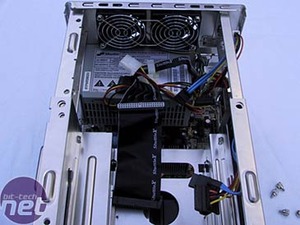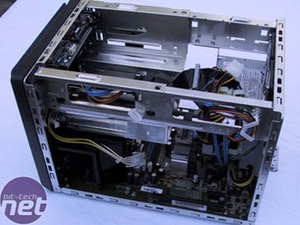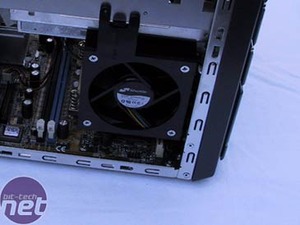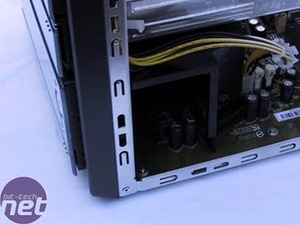Installation
Getting into the case is simply a matter of removing the thumbscrews and sliding off the cover - that is the simple part. Once you are inside the case, things get a little more difficult - we recommend you have a quick glance at the instructions before you delve in to taking the case apart. It is more of a case of knowing where to start, rather than it being exceptionally difficult to dissemble. The 'tool-less' installation claimed by Shuttle is as good as its word, as the 3.5" and 5.25" mounts simply slide out to reveal the ICE cooler underneath.Due to the way that the drives are hidden behind the cases' front panel, you can't use a slot loading 5.25" optical drive. However, it does accept every tray loading CD/DVD drive once you have adjusted the eject button placement on the front panel to ensure that it lines up correctly with the optical drives' own eject button.
Continuing the theme of tool-less installation, the provided brackets simply clip to your drives allowing the drives to slide in to place with relative ease. Shuttle even provided sticky rubber dampeners for application underneath the 5.25" optical drive to stop vibrations from being transmitted in to the hard drive below.


ICE CPU Cooling
The ICE (Internal Cooling Engine) is in its fourth revision in the SN25P. The method of removal is the same as it has always been in the form of four spring-loaded thumbscrews. Removing the ICE cooler may prove slightly fiddly though, especially if you have large hands. This might be the only case where a screwdriver is required to remove something from the case. The heat pipe technology still forms the basis of its design: the pipes are nickel-plated copper, designed to prevent corrosion. The base of the heatsink is constructed in copper and is lapped to a smooth, flat finish.Unlike some of the previous ICE revisions, this revision has two 80mm fans blowing air across the inside of the case, rather than a single fan blowing hot air out of the back. The pair of fans are capable of moving up to 50CFM of air in a push/pull motion. The air is ducted across the ICE CPU cooler with a large piece of removable plastic to ensure maximum efficiency from the cool air that is entering the case.


We foresee a slight problem with the lack of 4-pin molex connectors, as some users may want to install a GeForce 6800 Ultra along with a CD/DVD drive. A GeForce 6800 Ultra has a requirement for two power connectors to be connected to the 6-pin PCI-Express power adapter to deliver sufficient power to the video card. Shuttle has taken high-end users in to account by moving the PCI-Express x16 interconnect to the other side of the case, thus allowing for dual slot video cards to be installed. We don't think that it would have been too much effort for them to include a third 4-pin molex connector on the power supply unit.
BIOS
Shuttle has based the FN25's BIOS on the Phoenix AwardBIOS, and has given the user several options. CPU front side bus frequency is adjustable up to 250MHz, while the HyperTransport bus multiplier is adjustable from 1x to5x. The HyperTransport bus width can be set at 8x8 or 16x16. The memory timings are adjustable - it is possible to change tRAS, tRP, tRCD and CAS latencies, but there is no option to change the command rate. Command rate is important, as there are massive differences in efficiency between 2T and the faster 1T timing.The other important section of the BIOS controls the speed of the ICE cooling system. The ICE cooler's fan speed can be adjusted from Ultra-Low to "Extreme PC". The Extreme PC setting increases the ICE cooler's fans to their maximum speed when the CPU temperature reaches temperatures between 50°C and 65°C. Both the CPU and chipset have voltage adjustment up to 1.7v, while the memory voltage can be adjusted from 2.5v to 2.9v in 0.1v increments.
Software
As usual with NForce 4 motherboards you get NVIDIA RAID and Firewall software with NVIDIA's 'ActiveArmour' integrated into it. VIA's Envy Audio software provides support for environmental effects and positional audio selection, as well as sound sample rates and digital/analogue out and Dolby AC3/DTS decoding settings.
MSI MPG Velox 100R Chassis Review
October 14 2021 | 15:04







Want to comment? Please log in.